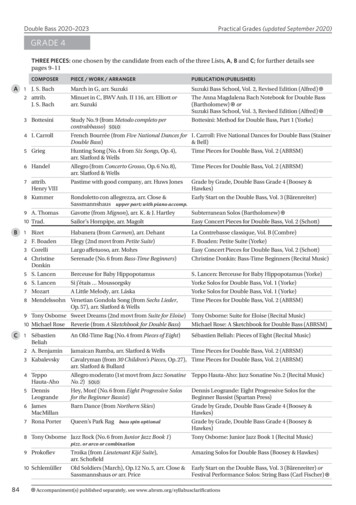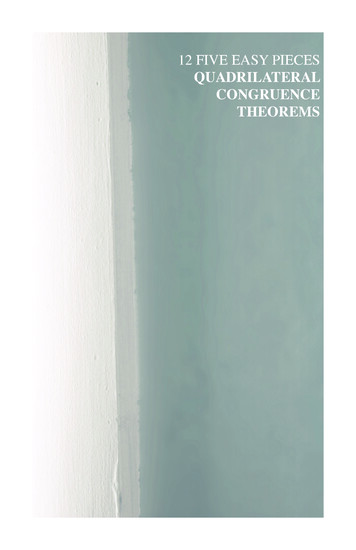
Transcription
12 five easy piecesquadrilateralcongruencetheorems
142lesson 12this is the last lesson in neutral geometry. after this, we will allow ourselves one more axiom dealing with parallel lines, and that is the axiomwhich turns neutral geometry into euclidean geometry. Before turningdown the euclidean path, let’s spend just a little time looking at quadrilaterals. the primary goal of this section will be to develop quadrilateral congruence theorems similar to the triangle congruence theorems wepicked up in earlier lessons.terminologyBefore i start working on congruence theorems, though, let me quicklyrun through the definitions of a few particular types of quadrilaterals.One of the risks that you run when you define an object by requiringit to have certain properties, as I have done above, is that you may definesomething that cannot be– something like an equation with no solution.The objects I have defined above are all such common shapes in everydaylife that we usually don’t question their existence. Here’s the interestingRh is no construction which guaranthing though– in neutralPageometry, thereTrReSqtees you can make a quadrilateral with four right angles– that is, neutralgeometry does not guarantee the existence of rectangles or squares. atthesame time, it doesto prohibitthe existence of squares or rectTrapezoida pairnothingof Parallelogramtwo pairs of parallel sides with three right angles prettyeasily,but once youdone that,Rhombusfourhavecongruentsides you have no control over the fourthangle,and the axiomsof neutralRectanglefour rightanglesgeometry are just not sufficient to proveSquarefourorcongruentsides andfour isrightanglesdefinitivelywhethernot that fourthanglea rightangle. This is oneof the fundamental differences that separates euclidean geometry fromnon-euclidean geometry. in euclidean geometry, Trthe fourth angle is aright angle, so there are rectangles. in non-euclidean geometry, the fourthPa When we eventuangle cannot be a right angle, so there are no rectangles.ally turn our attention to non-euclidean geometry, i want to come back tothis– i would like to begin that study with a more thorough investigationof these quadrilaterals that try to be like rectangles, but fail.RhRhombuses and rectanglesare parallelograms. Asquare is both a rhombusand a rectangle.SqRe
quadrilaterals143this is the last lesson in neutral geometry. after this, we will allow ourselves one more axiom dealing with parallel lines, and that is the axiomwhich turns neutral geometry into euclidean geometry. Before turningdown the euclidean path, let’s spend just a little time looking at quadrilaterals. the primary goal of this section will be to develop quadrilateral congruence theorems similar to the triangle congruence theorems wepicked up in earlier lessons.Quadrilaterals with three right angles. On the left, in Euclidean geometry, theterminologyfourth angle is a right angle. On the right, in non-Euclidean geometry, thefourth angle is acute.Before i start working on congruence theorems, though, let me quicklyrun through the definitions of a few particular types of quadrilaterals.One of the risks that you run when you define an object by requiringit to have certain properties, as I have done above, is that you may definesomething that cannot be– something like an equation with no solution.The objects I have defined above are all such common shapes in everydaylife that we usually don’t question their existence. Here’s the interestingthing though– in neutral geometry, there is no construction which guarantees you can make a quadrilateral with four right angles– that is, neutralgeometry does not guarantee the existence of rectangles or squares. atthe same time, it does nothing to prohibit the existence of squares or rectangles either. you can make a quadrilateral with three right angles prettyeasily, but once you have done that, you have no control over the fourthangle, and the axioms of neutral geometry are just not sufficient to provedefinitively whether or not that fourth angle is a right angle. This is oneof the fundamental differences that separates euclidean geometry fromnon-euclidean geometry. in euclidean geometry, the fourth angle is aright angle, so there are rectangles. in non-euclidean geometry, the fourthangle cannot be a right angle, so there are no rectangles. When we eventually turn our attention to non-euclidean geometry, i want to come back tothis– i would like to begin that study with a more thorough investigationof these quadrilaterals that try to be like rectangles, but fail.
144lesson 12quadrilateral congruencei feel that many authors view the quadrilateral congruences as a means toan end, and as such, tend to take a somewhat ad hoc approach to them. ithink i understand this approach– the quadrilateral congruence theoremsthemselves are a bit bland compared to their application. still, i want tobe a bit more systematic in my presentation of them. in the last chapterwe looked at several classes of polygons. to recap:{convex polygons} {simple polygons} {polygons}.for what we are going to be doing in this book, we really only needthe congruence results for convex quadrilaterals, but i am going to tryto tackle the slightly broader question of congruence for simple quadrilaterals. While the even broader question of congruence for non-simplequadrilaterals would be interesting, i think it is just too far of a detour.By definition, two quadrilaterals are congruent if four correspondingsides and four corresponding interior angles are congruent– that’s a totalof eight congruences. each congruence theorem says that you can guarantee congruence with some subset of that list. if you recall, for trianglesyou generally needed to know three of the six pieces of information. forquadrilaterals, it seems that the magic number is five. So what I wouldlike to do in this lesson is to look at all the different possible combinationsof five pieces (sides and angles) of a quadrilateral and determine whichlead to valid congruence theorems. i won’t give all the proofs or all thecounterexamples (that way you can tackle some of them on your own),but I will provide the framework for a complete classification.The first step is some basic combinatorics. Each of these theorems hasa five letter name consisting of some mix of Ss and As. When forming thisname, there are two choices, S and A for each of the five letters, and sothere are a total of 25 32 possible names. two of these, s·s·s·s·s anda·a·a·a·a, don’t make any sense in the context of quadrilateral congruences, though, since a quadrilateral doesn’t have five sides or five angles.that leaves thirty different words. now it is important to notice that notall of these words represent fundamentally different information about thequadrilaterals themselves. for instance, s·s·a·s·a and a·s·a·s·s bothrepresent the same information, just listed in reverse order. similarly,s·s·a·s·s and s·s·s·s·a both represent the same information– four sidesand one angle. once those equivalences are taken into consideration, weare left with ten potential quadrilateral congruences.
A·A·A·S·SSAAASASSAASSAAAAASSAyes( )yesSSASSASSSSno( )a valid congruence theorem for convex quadrilateralsTable 1. Quadrilateral congruence theorems.
146lesson 12s·a·s·a·s, a·s·a·s·a, and a·a·s·a·seach of these is a valid congruence theorem for simple quadrilaterals.the basic strategy for their proofs is to use a diagonal of the quadrilateralto separate it into two triangles, and then to use the triangle congruencetheorems. now the fact that i am allowing both convex and non-convexquadrilaterals in this discussion complicates things a little bit, so let’s startby examining the nature of the diagonals of a quadrilateral. yes, i will beleaving out a few details here (more than a few to be honest) so you shouldfeel free to work out any tricky details for yourself.consider a quadrilateral ABCD (I am going to use a square symbolto denote a simple quadrilateral). What I want to do is to look at the position of the point D relative to the triangle ABC. each of the three lines AB , BC , and AC separate the plane into two pieces. it is notpossible, though, for any point of the plane to simultaneously be(1) on the opposite side of AB from C(2) on the opposite side of AC from B, and(3) on the opposite side of BC from A.therefore the lines of ABC divide the plane into seven (23 1) distinctregions.now for each of these seven regions, we can determine whether thediagonalsAC and BD are in the interior of ABCD. let me point outIthat this is always an all-or-nothing proposition– either the entire diagonallies in the interior (excepting of course the endpoints) or none of it does.additionally,A in each case, a diagonal lies in the interior of a quadrilateralif and only if it lies in the interior of both the angles formed by ABCDat its endpoints. What i mean is that if, for example, AC is in the interiorVof ABCD, then AC will be in the interior of both DAB and BCD. ifVIIACIV isn’t in the interior of ABCD, then AC will not be in the interior ofeither DAB or BCD.CWith the diagonals now properly sorted, we can address the congruenceIIIBtheorems directly.perhaps the most useful of them all is s·a·s·a·s.VIIIs · a · s · a · s quadrilateral conGruenceif ABCD and A B C D are simple quadrilaterals andAB A B B B BC B C C C CD C D The seven “sides” of a triangle.then ABCD A B C D .
quadrilaterals147s·a·s·a·s, a·s·a·s·a, and a·a·s·a·seachof theseis a validD congruencetheorem for simplequadrilaterals.D is inis ABCDis on thereflexinteriorthebasic strategyproofsis :to use a diagonal ofanglethe quadrilateralsimple?for theirsameside ofdiagonal:regionto separate it into two triangles,useastheBC as A andAC thenas B to ABC triangle congruenceAC BDtheorems. now the fact that i am allowing both convex and non-convexquadrilateralsinI this discussion complicates things a little bit,A so let’s startby examining the nature of the diagonals of a quadrilateral. yes, i will beleavingII out a few details here (more than a few to be honest)B so you should feel free to work out any tricky details for yourself.considera quadrilateral ABCD (I am going to use aCsquare symbolIII to denote a simple quadrilateral). What I want to do is to look at the position ofIVthe point D relative to the triangle ABC. each of–the three– lines– AB , BC , and AC separate the plane into two pieces. it is notpossible,V though, for any point of the plane to simultaneously none be (1)VIon the opposite side of AB from C(2) on the opposite side of AC from B, and(3)on the oppositeside ofVII BC from A. – D–– diagonalsof aplanequadrilateraltherefore theTablelines 2.of The ABCdivide theinto seven (23 1) distinctregions.now for each of these seven regions, we can determine whether thediagonals AC and BD are in the interior of ABCD. let me point outthat this is always an all-or-nothing proposition– either the entire diagonallies in the interior (excepting of course the endpoints) or none of it does.additionally, in each case, a diagonal lies in the interior of a quadrilateralif and only if it lies in the interior of both the angles formed by ABCDat its endpoints. What i mean is that if, for example, AC is in the interiorof ABCD, then AC will be in the interior of both DAB and BCD. ifAC isn’t in the interior of ABCD, then AC will not be in the interior ofeither DAB or BCD.With the diagonals now properly sorted, we can address the congruencetheorems directly. perhaps the most useful of them all is s·a·s·a·s.s · a · s · a · s quadrilateral conGruenceif ABCD and A B C D are simple quadrilaterals andAB A B B B then ABCD A B C D .BC B C C C CD C D
148lesson 12Proof. the diagonals AC and A C are the keys to turning this into a problem of triangle congruence. unfortunately, we do not know whether or notthose diagonals are in the interiors of their respective quadrilaterals. thatmeans we have to tread somewhat carefully at first. Because of S·a·s, ABC A B C . you need to pay attention to what is happening at vertex C. if AC is in the interior of the quadrilateral, then it is in the interior of BCD and that means ( BCA) ( BCD). then, since B C A BCAand B C D BCD, ( B C A ) ( B C D ). therefore A C must bein the interior of B C D and in the interior of A B C D . With the samereasoning, we can argue that if AC is not in the interior of ABCD, thenA C cannot be in the interior of A B C D . so there are two cases, andABthe assemblyof the quadrilateral from the triangles depends upon the case.My diagram of the chase through the congruences is below. i have split it,when necessary, to address the differences in the two cases.CDusing essentially this same approach, you should be able to verify boththe a·s·a·s·a and a·a·s·a·s quadrilateral congruences.Given :SAS : ABCa CABAB ABCBC BCDCDAngle Sub n BCD ACD BCAAB ss ABC aBC ssa BCAss CA BCA BCD ACDAngle Sub nBADC
BCD and that means ( BCA) ( BCD). then, since B C A BCAand B C D BCD, ( B C A ) ( B C D ). therefore A C must bequadrilaterals149in the interior of B C D and in the interior of A B C D . With the samereasoning, we can argue that if AC is not in the interior of ABCD, thenA C cannot be in the interior of A B C D . so there are two cases, andthe assembly of the quadrilateral from the triangles depends upon the case.My diagram of the chase through the congruences is below. i have split it,when necessary, to address the differences in the two cases.using essentially this same approach, you should be able to verify boththe a·s·a·s·a and a·a·s·a·s quadrilateral congruences.SAS : ACDa DACAngle Add n DAC DAB CABAC ss ACD aCD ssa CDAss DA DAC CAB DABAngle Sub n
150lesson 12s·s·s·s·athe s·s·s·s·a condition is almost enough to guarantee quadrilateral congruence. suppose that you know the lengths of all four sides of ABCD,and you also know A. then BAD is completely determined (S·a·S)and from that BCD is completely determined (S·s·S). That still doesnot mean that ABCD is completely determined, though, because thereare potentially two ways to assemble BAD and BCD (as illustrated).one assembly creates a convex quadrilateral, the other a non-convex one.now, there will be times when you know the quadrilaterals in questionare all convex, and in those situations, s·s·s·s·a can be used to show thats·s·s·s·aconvexquadrilaterals are congruent.the s·s·s·s·a condition is almost enough to guarantee quadrilateral cona·s·a·a·s,a·s·a·s·s,a·a·a·a·s,andB s·s·s·a·agruence.supposethat youa·s·s·a·s,know the lengthsof all foursidesof ABCD,and you also know A. then BAD is completely determined (S·a·S)None of these provide sufficient information to guarantee congruence andand from that BCD is completely determined (S·s·S). That still doescounterexamples can be found in euclidean geometry. i will just do onenotmean that ABCD is completely determined,thereACC though, becauseNon-congruentofthem– s·s·s·a·a, and leave the rest for you to puzzle out. in the illusarepotentiallytwowaystoassemble BADand BCD(asillustrated).quadrilateralstrationbelow with ABCD and ABC D have correponding s·s·s·a·a butoneassemblycreates a convex quadrilateral, the other a non-convex one.matchingSSSSA.are not congruent.now,willthebe times when you know the quadrilateralsin questionOne isthereconvex;Dothernot. and in those situations, s·s·s·s·a can be used to show thatareallisconvex,convex quadrilaterals are congruent.a·s·a·a·s, a·s·a·s·s, a·s·s·a·s, a·a·a·a·s, and s·s·s·a·aNone of these provide sufficient information to guarantee congruence andcounterexamples can be found in euclidean geometry. i will just do oneof them– s·s·s·a·a, and leave the rest for you to puzzle out. in the illustration below ABCD and ABC D have correponding s·s·s·a·a butare not congruent.CCBNon-congruentquadrilaterals withmatching SSSAA.DDA
quadrilaterals151a·a·a·s·sthis is the intriguing one. the idea of splitting the quadrilateral into triangles along the diagonal just doesn’t work. you fail to get enough information about either triangle. Yet, (as we will see) in Euclidean geometry,the angle sum of a quadrilateral has to be 360 . since three of the angles are given, that means that in the euclidean realm the fourth angleis determined as well. in that case, this set of congruences is essentiallyequivalent to the a·s·a·s·A (which is a valid congruence theorem). Theproblem is that in neutral geometry the angle sum of a quadrilateral doesnot have to be 360 . Because of the saccheri-legendre theorem, the angle sum of a quadrilateral cannot be more than 360 , but that is all we cansay. it turns out that this is a valid congruence theorem in neutral geometry. The proof is a little difficult though. The argument that I want touse requires us to “drop a perpendicular”. i have described this process insome of the previous exercises, but let me reiterate here.1for any line and point P not on , there is a unique line through Pwhich is perpendicular to .leMthe intersection of and the perpendicular line is often called the footof the perpendicular. The process of finding this foot is called droppinga perpendicular. i have already proven the existence part of this– thephrasing was a little different then, but my proof of the existence of rightangles (in the lesson on angle comparison) constructs this perpendicularline. as for uniqueness part, i will leave that to you.2let be a line, P a point not on , and Q the foot of the perpendicularto through P. then P is closer to Q than it is to any other point on .leMagain, i am going to pass off the proof to you. i would suggest, though,that you think about the scalene triangle theorem. now on to the maintheorem.
152lesson 12aa ·· aa ·· aa ·· ss ·· ss quadrilateralquadrilateral conGruenceconGruence C D are simple quadrilaterals, andif ABCDif ABCD andand AA BB C D are simple quadrilaterals, and A A A A B B B B C C C C CDCD CC DD C D .thenthen ABCDABCD AA BB C D . DADA DD AA Proof.Proof. ii willwill useuse aa proofproof byby contradictioncontradiction ofof thisthis somewhatsomewhat trickytricky theotheo B C D have the corresponding conrem.supposethat ABCDand A rem. suppose that ABCD and A B C D have the corresponding congruentgruent piecespieces asas describeddescribed inin thethe statementstatement ofof thethe theorem,theorem, butbut supposesuppose B C D are not themselves congruent.that ABCDand A that ABCD and A B C D are not themselves congruent.a · a · a · s · s quadrilateral conGruencePartOne,inestablish C D areparallelPartOne,in whichwhichweestablishparallellines.if ABCDand weA Bsimple lines.quadrilaterals,and CD will overlap ABCDii wanttoconstructanewquadrilateral:B CD will overlap ABCDwant to construct a new quadrilateral: AA B C . Here is the conaswillcongruent B C to isDtheA con A as possible, A Bbutas muchmuchaspossible,butwill bebe CcongruenttoCD AA BBC CD DD . DAHere onCB sothatCB CB.notethatBCandstruction.locateB B CC struction. locate B on CB so that CB C B . note that BC and B then ABCD eralswouldbeconcannot be congruent– if they were the two quadrilaterals would be con gruentthe otherothergruent byby a·a·s·a·s.a·a·s·a·s. asas aa result,result, inin thethe construction,construction, BB BB . the .itneedstobepositionedsothat:pointtoplaceisA Proof.toiplacewill useby tocontradictionofsothissomewhat tricky theoit needsbe positionedthat:pointis Aa. proofrem. suppose that ABCD and A B C D have the corresponding con1.onsideasgruentpiecesassamedescribedthe statement1. itit isison thethesameside ofofin BC BC as A,A, of the theorem, but suppose C A B C , and 2. AB thatABCD AB BCC, andD are not themselves congruent.2. ABC and A A B .3.B A B .3. AA BPart One, in which we establish parallel lines. B CD wantto constructa newquadrilateral: Aguaranteetheangleand apthere isis oneoneand ishesthecopying–asmuchbut will thesebe congruentto ThatA B CfinishesD . Herethe cononlyoneaspointthat satisfiesconditions.theiscopying–A possible, CD and A B C D are . note that there C by CD C DCBand soC Bcongruent.BC andisstruction.locateB Bby s·a·s·a·s,s·a·s·a·s, AABonA BCBarecongruent.thereis BoneoneB thatimportantthingtosincecannotcongruent–they thiswereconstruction.the two Aquadrilateralswould be conimportantto notenoteifaboutaboutthisconstruction.sinceA be thing gruent by a·a·s·a·s. as a result,in the construction, B B . the BotherB A B C B C ABC, A B Cto be AB C ABC,needspositionedso that:point to place is A . it A and AB theinteriorangletheoremguaranteesthatB and AB eesthat A A Bitisonthesamesideof BC asA,DCDCwillbeparallel.willparallel. C A B C , and2. be AB . theA Bproof3. setupA B forTheof AAASS for convex quadrilaterals.the angle and segment construction axioms guarantee that there is one andonly one point that satisfies these conditions. That finishes the copying–by s·a·s·a·s, A B CD and A B C D are congruent. there is oneimportant thing to note about this construction. since A B C A B C ABC,
the angle and segment construction axioms guarantee that there is one andonly one point that satisfies these conditions. That finishes the copying–quadrilaterals153by s·a·s·a·s, A B CD and A B C D are congruent. there is oneimportant thing to note about this construction. since A B C A B C ABC,the alternate interior angle theorem guarantees that A B and AB will be parallel.Part two, in which we determine the position of D relative to those lines.the two parallel lines AB and A B carve the plane into threeregions as shown in the illustration below. the reason i mention this isthat my proof will not work if D is in region 2, the region between thetwo parallel lines. now it is pretty easy to show that D will not fall inregion 2 if we know the1two quadrilaterals are convex. if we don’t knowAthat, though, the situation getsB a little more delicate, and we will have tolook for possible reflex2 angles in the two quadrilaterals. The key thing toA is that the angle sum of a simple quadrilateral is at most 360 keep in mindB(a consequence of the Saccheri-Legendre Theorem), and the measure ofa reflex angle is more than 180 – therefore, a simple quadrilateral will3 reflex angle.support at most onesupposeD didliein regionnote that,basedupontoourconstrucParttwo, inthatwhichwedeterminethe2.positionof Drelativethoselines. or Clines. B, and so that means that C is not in regionRegionsbetweenparallel Btion,eitherC B B intothreethe two parallel lines AB and A B carve the plane ) comes beB2.Therefore,oneofthetwolines(either AB or Aregions as shown in the illustration below. the reason i mention this istweenC proofand Dwillwhileotherifdoesthe twoare equivalent,sothatmynottheworkD isnot.in region2, casesthe regionbetween ’sassumefortheresttwo parallel lines. nowit is pretty easy to show that D will not fall in B separates C and D, but that AB does not.ofthisproofthat Aregion 2 if we know the two quadrilaterals are convex. if we don’t knowWhatare the implicationsthis?let mereferyou backtablewhichthat, though,the situation ofgetsa littlemoredelicate,andtowewill ertexofaquadrilateralinlook for possible reflex angles in the two quadrilaterals. The key thing torelationto theispreviousthree. sum of a simple quadrilateral is at most 360 keep in mindthat the angle(a consequence of the Saccheri-Legendre Theorem), and the measure ofa reflex angle is more than 180 – therefore, a simple quadrilateral willsupport at most one reflex angle.suppose that D did lie in region 2. note that, based upon our construction, either C B B or C B B, and so that means that C is not in region2. Therefore, one of the two lines (either AB or A B ) comes between C and D while the other does not. the two cases are equivalent, soin the interest of keeping the notation reasonable, let’s assume for the restof this proof that A B separates C and D, but that AB does not.What are the implications of this? let me refer you back to table 2 whichcharacterizes the possible positions of a fourth vertex of a quadrilateral inrelation to the previous three.
in the interest of keeping the notation reasonable, let’s assume for the restof this proof that A B separates C and D, but that AB lessondoes not.12154What are the implications of this? let me refer you back to table 2 whichcharacterizes the possible positions of a fourth vertex of a quadrilateral inrelation to the previous three.IAIIIVBVIIIAIVIIBVIIVVICVVICIIIIIIsince C and D are on the same sideof AB , D has to be in regioniii, iv, or v with respect to ABC(note that if D is in region vi, then ABCD is not simple). If D is inregion iii, then ABCD has a reflex angle at C. if D is in region v,then ABCD is convex and doesnot have a reflex angle. And if Dis in region vii, then ABCD hasa reflex angle at D.since C and D are on opposite sides A B , D has to be in regionI or II (if D is in region iv, then A B CD is not simple. if D is inregion i, then A B CD has a reflex angle at A . if D is in regionii, then A B CD has a reflex angle at B .A quadrilateral can only have one reflex angle, so in ABCD neither Anor B is reflex. In A B CD one of A or B is reflex. Rememberthough that A A and B B. this is a contradiction– obviouslytwo angles cannot be congruent if one has a measure over 180 while theother has a measure less than that. so now we know that D cannot liebetween AB and A B and so all the points of AB are on theopposite side of A B from D.Part Three, in which we measure the distance from D to those lines.I would like to divide the rest of the proof into two cases. The first casedeals with the situation when A and A (which are congruent) are rightangles. the second deals with the situation where they are not.case 1. ( A) ( A ) 90 .
quadrilateralsAAP155BBPart Three, in which we measure the distance from D to those lines.C of the proof into two cases. The first caseI wouldDlike to divide the restdeals with the situation when A and A (which are congruent) are rightCase 1:thethe angleat dealsA is a withright angle.angles.secondthe situation where they are not.case 1. ( A) ( A ) 90 .since D and A are on opposite sides of A B , there is a point P betweenA and D which is on A B . then DP DA DA .But that can’t happen, since A is the closest point on A B to D.) measure90 . the distance from D to those lines.caseThree,2. ( A)( A wePartin whichapproachis quitesimilarto proofthe oneintoin case1. theThedifferenceisIthewouldlike toheredividethe restof thetwo cases.first casethat weareAthegoingto haveto makethe Arightanglesarefirst.Locate E areandrightE , (whichcongruent)dealswithsituationwhen A and EB ,respectively.the feet theof theperpendicularsD to AB andthey A areBangles.seconddeals withfromthe situationwherenot. EpleaseA turn your attention to triangles DAE and DA E . in them,Bcase 1. ( A) P( A ) 90 .AD A D A A E E .since D and A are on opposite sides of A B , there is a point P betweenAD whichoncongruent, A B . thenByanda·a·s,theyisareand that means that DE DE . But thatDCcreates essentiallythe same problemthat we sawin the first case. Since D DP DA DA . and E are on opposite sides of A B , there is a point P between D andCase 2: the angle atA is not a right angle.thenEwhichis on happen, A E .Butthat can’tsinceA is the closest point on A B to D.case 2. ( A) ( A ) 90 . DP DE DE .the approach here is quite similar to the one in case 1. the difference is that we thisare goinghave to makeright anglesLocateandshouldbe the first.closestpointE toD Eon,again,cannotto happen,as E the E .the feetof the perpendiculars from D to AB and A B , respectively. Aplease turn your attention to triangles DAE and DA E . in them,in either case, we have reacheda contradiction. the initial assumption,AD A D A A E E . that ABCD and A B C D are not congruent, must be false.By a·a·s, they are congruent, and that means that DE DE . But thatcreates essentially the same problem that we saw in the first case. Since Dand E are on opposite sides of A B , there is a point P between D andE which is on A E . then
AD A D A A E E .But thatthey are congruent, and that means that DE DE .lesson12creates essentially the same problem that we saw in the first case. Since Dand E are on opposite sides of A B , there is a point P between D andE which is on A E . thenBy a·a·s,156 DP DE DE .again, this cannot happen, as E should be the closest point to D on A E .in either case, we have reached a contradiction. the initial assumption,that ABCD and A B C D are not congruent, must be false.
quadrilaterals157exercises1. a convex quadrilateral with two pairs of congruent adjacent sides iscalled a kite. prove that the diagonals of a k
12 five easy pieces quadrilateral congruence theorems. 142 lesson 12 this is the last lesson in neutral geometry. after this, we will allow our-selves one more axiom dealing with parallel lines, and that is the axiom which turns neutral geometry into euclidean geometry. Before turning
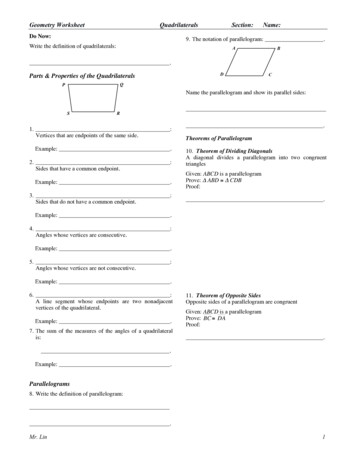
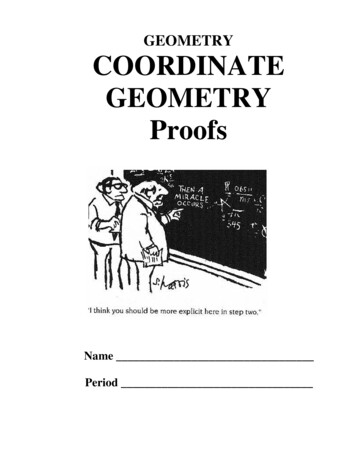
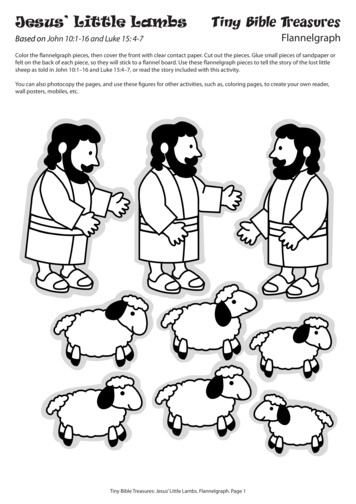
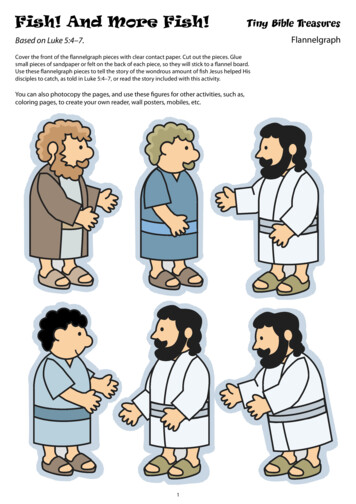

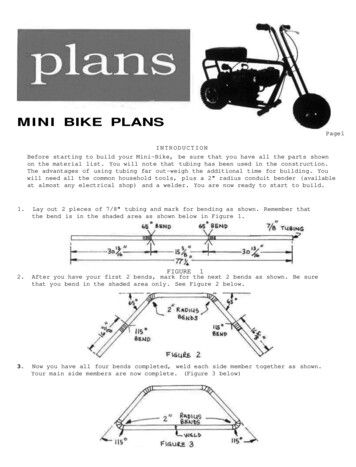


![[SURVEY PREVIEW MODE] DLIS SURVEY - fao](/img/19/dlis-questionnaire.jpg)

